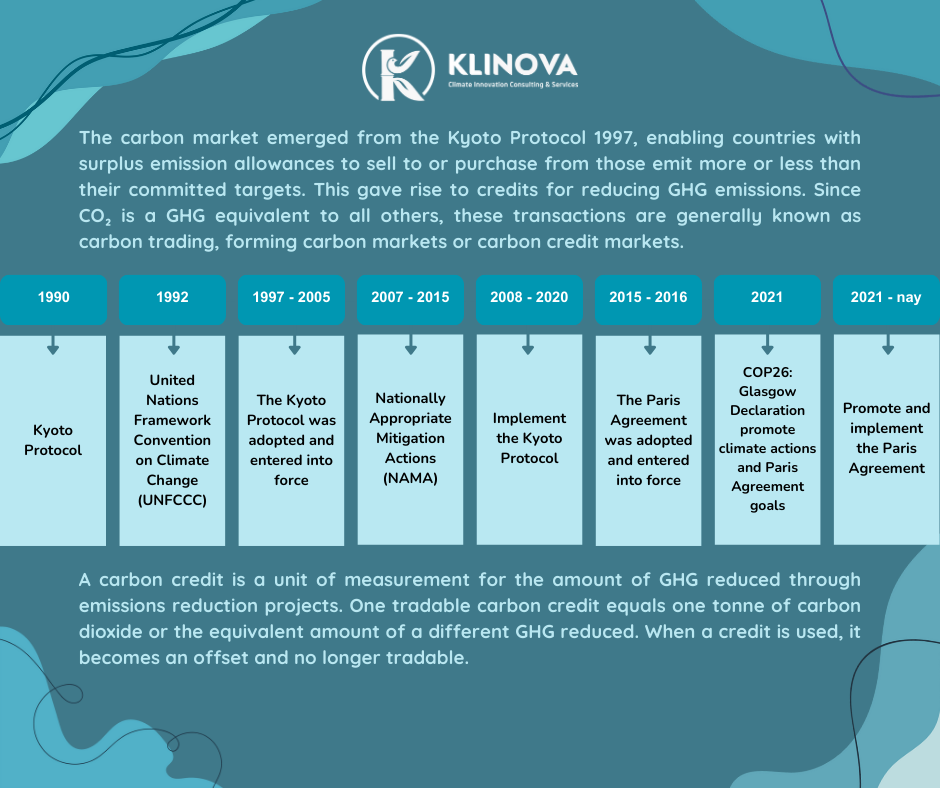The carbon market plays a pivotal role in global efforts to mitigate the impacts of climate change. By facilitating the exchange of carbon credits, nations and businesses can achieve their net-zero emission targets more efficiently.
1. Overview of Carbon Markets
The carbon market emerged from the Kyoto Protocol 1997, enabling countries with surplus emission allowances to sell to or purchase from those emit more or less than their committed targets. This gave rise to a new commodity, which is credits for reducing greenhouse gas (GHG) emissions. Since CO₂ is a GHG equivalent to all others, these transactions are generally known as carbon trading, forming carbon markets or carbon credit markets.

A carbon credit is a unit of measurement for the amount of GHG reduced or avoided through emissions reduction projects or activities. One tradable carbon credit equals one tonne of carbon dioxide or the equivalent amount of a different GHG reduced. When a credit is used, it becomes an offset and no longer tradable.
2. Types of Carbon Markets
Carbon markets are categorized into: Compliance Carbon Market; Voluntary Carbon Market; Carbon market under Article 6 of the Paris Agreement.
2.1. Compliance Carbon Market
Compliance carbon markets are established by legal regulations and supervised under national or international agreements, such as the Kyoto Protocol and the European Union Emissions Trading System (EU ETS). Companies must comply with the emissions cap. Those that emit less than their allocated cap can sell excess credits, while those exceeding their caps have to purchase for credits to offset their surplus emissions. Some notable compliance carbon markets include:
2.2. Voluntary Carbon Market
Unlike compliance carbon markets, the voluntary carbon market allows businesses, organizations, or individuals to purchase carbon credits to offset their emissions without being bound by legal regulations. The supply of voluntary credits primarily comes from private organizations that develop carbon reduction projects or government programs certified under carbon standards to mitigate and/or eliminate emissions. On the demand side, credits are sought by individuals aiming to offset their carbon footprints, businesses with sustainability goals, and other entities looking to trade credits for profit. As more companies commit to carbon neutrality or net-zero emissions, the voluntary carbon market continues to expand. Key standards in the voluntary carbon market include Verra (VCS), Gold Standard (GS), American Carbon Registry (ACR), Climate Action Reserve (CAR), and Plan Vivo (PVC).
2.3. Carbon Market under Article 6 Paris Agreement
Article 6.4 of Paris Agreement revolutionises the global trade in CO2 certificates. In COP29, nations reached a consensus on new operational standards for the carbon market under Article 6. This allows countries to transfer emissions reductions, in the form of carbon credits, to meet their Nationally Determined Contributions (NDCs). It aims to encourage investment flows into emission reduction projects through international cooperation and enhance transparency in the carbon market. Article 6 mechanisms include:
3. Conclusion
Carbon markets are trading systems in which carbon credits are sold and bought to offset emissions. The compliance market ensures adherence to emission targets, while the voluntary market offers opportunities for organizations and individuals to contribute to climate change mitigation. The Paris Agreement’s mechanisms are set to enhance international collaboration and channel investments into emission-reduction projects, particularly in developing nations.